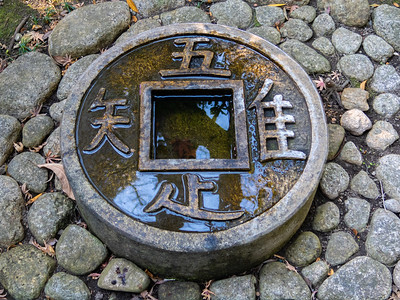The original is on a tsukubai (蹲踞, stone water basin to purify before entering a temple) at Ryoanji (龍安寺) temple in Kyoto but this one is at the Hase Dera (長谷寺) temple in Kamakura. The four characters "五", "隹", "止" και "矢" alone don't mean anything (actually they mean "five", "bird", "stop" and "arrow" but when they are combined with the character "口" ("mouth") in the center they become "吾", "唯", "足", "知" and they mean "I", "only", "need/necessary/enough" and "know". When they are read together they become the phrase "吾唯足知" (ware tada taru wo shiru) which means "I know only what is necessary" or, in other words "I am content with what I have".
(For a bigger version of this picture both in color and black and white, check my "Japan Arekore" set on Flickr).


0 comments:
Post a Comment